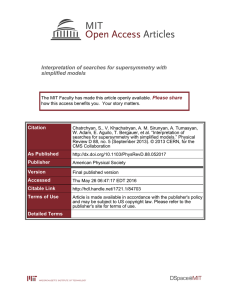Search for a light Higgs boson decaying to two gluons... ss in the radiative decays of (1S) Please share
advertisement
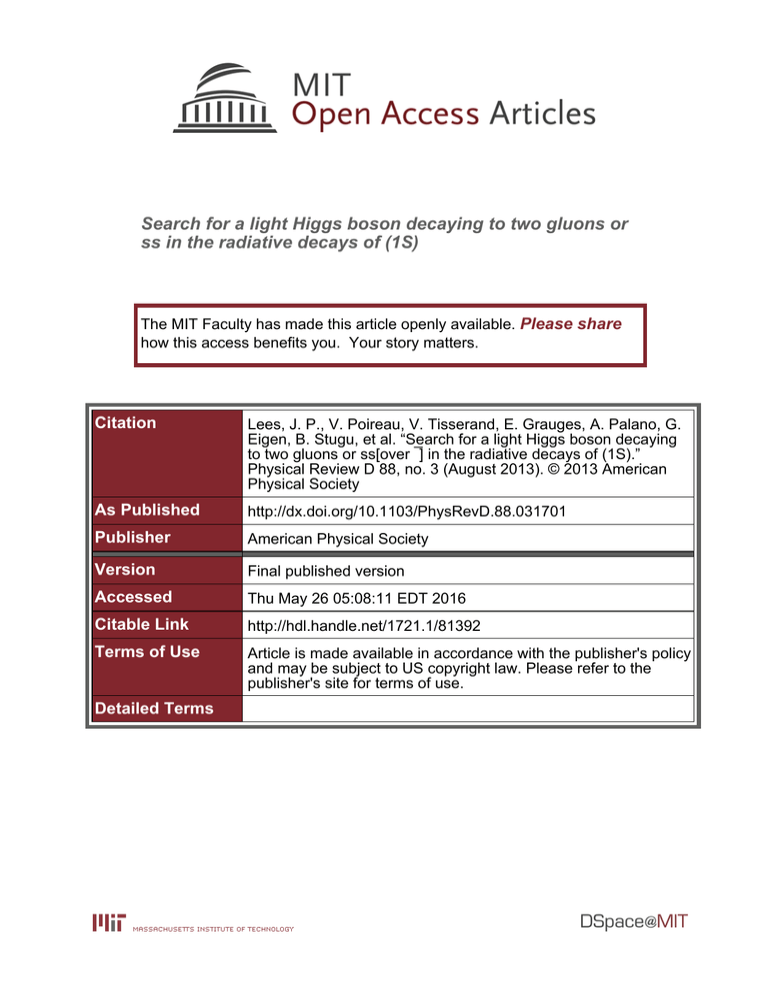
Search for a light Higgs boson decaying to two gluons or ss in the radiative decays of (1S) The MIT Faculty has made this article openly available. Please share how this access benefits you. Your story matters. Citation Lees, J. P., V. Poireau, V. Tisserand, E. Grauges, A. Palano, G. Eigen, B. Stugu, et al. “Search for a light Higgs boson decaying to two gluons or ss[over ¯] in the radiative decays of (1S).” Physical Review D 88, no. 3 (August 2013). © 2013 American Physical Society As Published http://dx.doi.org/10.1103/PhysRevD.88.031701 Publisher American Physical Society Version Final published version Accessed Thu May 26 05:08:11 EDT 2016 Citable Link http://hdl.handle.net/1721.1/81392 Terms of Use Article is made available in accordance with the publisher's policy and may be subject to US copyright law. Please refer to the publisher's site for terms of use. Detailed Terms RAPID COMMUNICATIONS PHYSICAL REVIEW D 88, 031701(R) (2013) Search for a light Higgs boson decaying to two gluons or ss in the radiative decays of ð1SÞ J. P. Lees,1 V. Poireau,1 V. Tisserand,1 E. Grauges,2 A. Palano,3a,3b G. Eigen,4 B. Stugu,4 D. N. Brown,5 L. T. Kerth,5 Yu. G. Kolomensky,5 M. J. Lee,5 G. Lynch,5 H. Koch,6 T. Schroeder,6 C. Hearty,7 T. S. Mattison,7 J. A. McKenna,7 R. Y. So,7 A. Khan,8 V. E. Blinov,9a,9c A. R. Buzykaev,9a V. P. Druzhinin,9a,9b V. B. Golubev,9a,9b E. A. Kravchenko,9a,9b A. P. Onuchin,9a,9c S. I. Serednyakov,9a,9b Yu. I. Skovpen,9a,9b E. P. Solodov,9a,9b K. Yu. Todyshev,9a,9b A. N. Yushkov,9a D. Kirkby,10 A. J. Lankford,10 M. Mandelkern,10 B. Dey,11 J. W. Gary,11 O. Long,11 G. M. Vitug,11 C. Campagnari,12 M. Franco Sevilla,12 T. M. Hong,12 D. Kovalskyi,12 J. D. Richman,12 C. A. West,12 A. M. Eisner,13 W. S. Lockman,13 B. A. Schumm,13 A. Seiden,13 D. S. Chao,14 C. H. Cheng,14 B. Echenard,14 K. T. Flood,14 D. G. Hitlin,14 P. Ongmongkolkul,14 F. C. Porter,14 R. Andreassen,15 Z. Huard,15 B. T. Meadows,15 B. G. Pushpawela,15 M. D. Sokoloff,15 L. Sun,15 P. C. Bloom,16 W. T. Ford,16 A. Gaz,16 U. Nauenberg,16 J. G. Smith,16 S. R. Wagner,16 R. Ayad,17,* W. H. Toki,17 B. Spaan,18 R. Schwierz,19 D. Bernard,20 M. Verderi,20 S. Playfer,21 D. Bettoni,22a C. Bozzi,22a R. Calabrese,22a,22b G. Cibinetto,22a,22b E. Fioravanti,22a,22b I. Garzia,22a,22b E. Luppi,22a,22b L. Piemontese,22a V. Santoro,22a R. Baldini-Ferroli,23 A. Calcaterra,23 R. de Sangro,23 G. Finocchiaro,23 S. Martellotti,23 P. Patteri,23 I. M. Peruzzi,23,† M. Piccolo,23 M. Rama,23 A. Zallo,23 R. Contri,24a,24b E. Guido,24a,24b M. Lo Vetere,24a,24b M. R. Monge,24a,24b S. Passaggio,24a C. Patrignani,24a,24b E. Robutti,24a B. Bhuyan,25 V. Prasad,25 M. Morii,26 A. Adametz,27 U. Uwer,27 H. M. Lacker,28 P. D. Dauncey,29 U. Mallik,30 C. Chen,31 J. Cochran,31 W. T. Meyer,31 S. Prell,31 A. V. Gritsan,32 N. Arnaud,33 M. Davier,33 D. Derkach,33 G. Grosdidier,33 F. Le Diberder,33 A. M. Lutz,33 B. Malaescu,33,‡ P. Roudeau,33 A. Stocchi,33 G. Wormser,33 D. J. Lange,34 D. M. Wright,34 J. P. Coleman,35 J. R. Fry,35 E. Gabathuler,35 D. E. Hutchcroft,35 D. J. Payne,35 C. Touramanis,35 A. J. Bevan,36 F. Di Lodovico,36 R. Sacco,36 G. Cowan,37 J. Bougher,38 D. N. Brown,38 C. L. Davis,38 A. G. Denig,39 M. Fritsch,39 W. Gradl,39 K. Griessinger,39 A. Hafner,39 E. Prencipe,39 K. Schubert,39 R. J. Barlow,40,§ G. D. Lafferty,40 E. Behn,41 R. Cenci,41 B. Hamilton,41 A. Jawahery,41 D. A. Roberts,41 R. Cowan,42 D. Dujmic,42 G. Sciolla,42 R. Cheaib,43 P. M. Patel,43,∥ S. H. Robertson,43 P. Biassoni,44a,44b N. Neri,44a F. Palombo,44a,44b L. Cremaldi,45 R. Godang,45,¶ P. Sonnek,45 D. J. Summers,45 M. Simard,46 P. Taras,46 G. De Nardo,47a,47b D. Monorchio,47a,47b G. Onorato,47a,47b C. Sciacca,47a,47b M. Martinelli,48 G. Raven,48 C. P. Jessop,49 J. M. LoSecco,49 K. Honscheid,50 R. Kass,50 J. Brau,51 R. Frey,51 N. B. Sinev,51 D. Strom,51 E. Torrence,51 E. Feltresi,52a,52b M. Margoni,52a,52b M. Morandin,52a M. Posocco,52a M. Rotondo,52a G. Simi,52a F. Simonetto,52a,52b R. Stroili,52a,52b S. Akar,53 E. Ben-Haim,53 M. Bomben,53 G. R. Bonneaud,53 H. Briand,53 G. Calderini,53 J. Chauveau,53 Ph. Leruste,53 G. Marchiori,53 J. Ocariz,53 S. Sitt,53 M. Biasini,54a,54b E. Manoni,54a S. Pacetti,54a,54b A. Rossi,54a C. Angelini,55a,55b G. Batignani,55a,55b S. Bettarini,55a,55b M. Carpinelli,55a,55b,** G. Casarosa,55a,55b A. Cervelli,55a,55b F. Forti,55a,55b M. A. Giorgi,55a,55b A. Lusiani,55a,55c B. Oberhof,55a,55b E. Paoloni,55a,55b A. Perez,55a G. Rizzo,55a,55b J. J. Walsh,55a D. Lopes Pegna,56 J. Olsen,56 A. J. S. Smith,56 R. Faccini,57a,57b F. Ferrarotto,57a F. Ferroni,57a,57b M. Gaspero,57a,57b L. Li Gioi,57a G. Piredda,57a C. Bünger,58 O. Grünberg,58 T. Hartmann,58 T. Leddig,58 C. Voß,58 R. Waldi,58 T. Adye,59 E. O. Olaiya,59 F. F. Wilson,59 S. Emery,60 G. Hamel de Monchenault,60 G. Vasseur,60 Ch. Yèche,60 F. Anulli,61,†† D. Aston,61 D. J. Bard,61 J. F. Benitez,61 C. Cartaro,61 M. R. Convery,61 J. Dorfan,61 G. P. Dubois-Felsmann,61 W. Dunwoodie,61 M. Ebert,61 R. C. Field,61 B. G. Fulsom,61 A. M. Gabareen,61 M. T. Graham,61 C. Hast,61 W. R. Innes,61 P. Kim,61 M. L. Kocian,61 D. W. G. S. Leith,61 P. Lewis,61 D. Lindemann,61 B. Lindquist,61 S. Luitz,61 V. Luth,61 H. L. Lynch,61 D. B. MacFarlane,61 D. R. Muller,61 H. Neal,61 S. Nelson,61 M. Perl,61 T. Pulliam,61 B. N. Ratcliff,61 A. Roodman,61 A. A. Salnikov,61 R. H. Schindler,61 A. Snyder,61 D. Su,61 M. K. Sullivan,61 J. Va’vra,61 A. P. Wagner,61 W. F. Wang,61 W. J. Wisniewski,61 M. Wittgen,61 D. H. Wright,61 H. W. Wulsin,61 V. Ziegler,61 W. Park,62 M. V. Purohit,62 R. M. White,62,‡‡ J. R. Wilson,62 A. Randle-Conde,63 S. J. Sekula,63 M. Bellis,64 P. R. Burchat,64 T. S. Miyashita,64 E. M. T. Puccio,64 M. S. Alam,65 J. A. Ernst,65 R. Gorodeisky,66 N. Guttman,66 D. R. Peimer,66 A. Soffer,66 S. M. Spanier,67 J. L. Ritchie,68 A. M. Ruland,68 R. F. Schwitters,68 B. C. Wray,68 J. M. Izen,69 X. C. Lou,69 F. Bianchi,70a,70b F. De Mori,70a,70b A. Filippi,70a D. Gamba,70a,70b S. Zambito,70a,70b L. Lanceri,71a,71b L. Vitale,71a,71b F. Martinez-Vidal,72 A. Oyanguren,72 P. Villanueva-Perez,72 H. Ahmed,73 J. Albert,73 Sw. Banerjee,73 F. U. Bernlochner,73 H. H. F. Choi,73 G. J. King,73 R. Kowalewski,73 M. J. Lewczuk,73 T. Lueck,73 I. M. Nugent,73 J. M. Roney,73 R. J. Sobie,73 N. Tasneem,73 T. J. Gershon,74 P. F. Harrison,74 T. E. Latham,74 H. R. Band,75 S. Dasu,75 Y. Pan,75 R. Prepost,75 and S. L. Wu75 1550-7998= 2013=88(3)=031701(7) 031701-1 Ó 2013 American Physical Society RAPID COMMUNICATIONS J. P. LEES et al. PHYSICAL REVIEW D 88, 031701(R) (2013) (BABAR Collaboration) 1 Laboratoire d’Annecy-le-Vieux de Physique des Particules (LAPP), Université de Savoie, CNRS/IN2P3, F-74941 Annecy-Le-Vieux, France 2 Departament ECM, Facultat de Fisica, Universitat de Barcelona, E-08028 Barcelona, Spain 3a INFN Sezione di Bari, I-70126 Bari, Italy 3b Dipartimento di Fisica, Università di Bari, I-70126 Bari, Italy 4 Institute of Physics, University of Bergen, N-5007 Bergen, Norway 5 Lawrence Berkeley National Laboratory and University of California, Berkeley, California 94720, USA 6 Institut für Experimentalphysik 1, Ruhr Universität Bochum, D-44780 Bochum, Germany 7 University of British Columbia, Vancouver, British Columbia, Canada V6T 1Z1 8 Brunel University, Uxbridge, Middlesex UB8 3PH, United Kingdom 9a Budker Institute of Nuclear Physics SB RAS, Novosibirsk 630090, Russia 9b Novosibirsk State University, Novosibirsk 630090, Russia 9c Novosibirsk State Technical University, Novosibirsk 630092, Russia 10 University of California at Irvine, Irvine, California 92697, USA 11 University of California at Riverside, Riverside, California 92521, USA 12 University of California at Santa Barbara, Santa Barbara, California 93106, USA 13 Institute for Particle Physics, University of California at Santa Cruz, Santa Cruz, California 95064, USA 14 California Institute of Technology, Pasadena, California 91125, USA 15 University of Cincinnati, Cincinnati, Ohio 45221, USA 16 University of Colorado, Boulder, Colorado 80309, USA 17 Colorado State University, Fort Collins, Colorado 80523, USA 18 Fakultät Physik, Technische Universität Dortmund, D-44221 Dortmund, Germany 19 Institut für Kern- und Teilchenphysik, Technische Universität Dresden, D-01062 Dresden, Germany 20 Laboratoire Leprince-Ringuet, Ecole Polytechnique, CNRS/IN2P3, F-91128 Palaiseau, France 21 University of Edinburgh, Edinburgh EH9 3JZ, United Kingdom 22a INFN Sezione di Ferrara, I-44122 Ferrara, Italy 22b Dipartimento di Fisica e Scienze della Terra, Università di Ferrara, I-44122 Ferrara, Italy 23 INFN Laboratori Nazionali di Frascati, I-00044 Frascati, Italy 24a INFN Sezione di Genova, I-16146 Genova, Italy 24b Dipartimento di Fisica, Università di Genova, I-16146 Genova, Italy 25 Indian Institute of Technology Guwahati, Guwahati, Assam 781 039, India 26 Harvard University, Cambridge, Massachusetts 02138, USA 27 Physikalisches Institut, Universität Heidelberg, D-69120 Heidelberg, Germany 28 Institut für Physik, Humboldt-Universität zu Berlin, D-12489 Berlin, Germany 29 Imperial College London, London SW7 2AZ, United Kingdom 30 University of Iowa, Iowa City, Iowa 52242, USA 31 Iowa State University, Ames, Iowa 50011-3160, USA 32 Johns Hopkins University, Baltimore, Maryland 21218, USA 33 Laboratoire de l’Accélérateur Linéaire, Centre Scientifique d’Orsay, IN2P3/CNRS et Université Paris-Sud 11, F-91898 Orsay Cedex, France 34 Lawrence Livermore National Laboratory, Livermore, California 94550, USA 35 University of Liverpool, Liverpool L69 7ZE, United Kingdom 36 Queen Mary, University of London, London E1 4NS, United Kingdom 37 University of London, Royal Holloway and Bedford New College, Egham, Surrey TW20 0EX, United Kingdom 38 University of Louisville, Louisville, Kentucky 40292, USA 39 Institut für Kernphysik, Johannes Gutenberg-Universität Mainz, D-55099 Mainz, Germany 40 University of Manchester, Manchester M13 9PL, United Kingdom 41 University of Maryland, College Park, Maryland 20742, USA 42 Laboratory for Nuclear Science, Massachusetts Institute of Technology, Cambridge, Massachusetts 02139, USA 43 McGill University, Montréal, Québec, Canada H3A 2T8 44a INFN Sezione di Milano, I-20133 Milano, Italy 44b Dipartimento di Fisica, Università di Milano, I-20133 Milano, Italy 45 University of Mississippi, University, Mississippi 38677, USA 46 Université de Montréal, Physique des Particules, Montréal, Québec, Canada H3C 3J7 47a INFN Sezione di Napoli, I-80126 Napoli, Italy 47b Dipartimento di Scienze Fisiche, Università di Napoli Federico II, I-80126 Napoli, Italy 48 NIKHEF, National Institute for Nuclear Physics and High Energy Physics, NL-1009 DB Amsterdam, Netherlands 031701-2 RAPID COMMUNICATIONS SEARCH FOR A LIGHT HIGGS BOSON DECAYING TO . . . PHYSICAL REVIEW D 88, 031701(R) (2013) 49 University of Notre Dame, Notre Dame, Indiana 46556, USA 50 Ohio State University, Columbus, Ohio 43210, USA 51 University of Oregon, Eugene, Oregon 97403, USA 52a INFN Sezione di Padova, I-35131 Padova, Italy 52b Dipartimento di Fisica, Università di Padova, I-35131 Padova, Italy 53 Laboratoire de Physique Nucléaire et de Hautes Energies, IN2P3/CNRS, Université Pierre et Marie Curie-Paris6, Université Denis Diderot-Paris7, F-75252 Paris, France 54a INFN Sezione di Perugia, I-06123 Perugia, Italy 54b Dipartimento di Fisica, Università di Perugia, I-06123 Perugia, Italy 55a INFN Sezione di Pisa, I-56127 Pisa, Italy 55b Dipartimento di Fisica, Università di Pisa, I-56127 Pisa, Italy 55c Scuola Normale Superiore di Pisa, I-56127 Pisa, Italy 56 Princeton University, Princeton, New Jersey 08544, USA 57a INFN Sezione di Roma, I-00185 Roma, Italy 57b Dipartimento di Fisica, Università di Roma La Sapienza, I-00185 Roma, Italy 58 Universität Rostock, D-18051 Rostock, Germany 59 Rutherford Appleton Laboratory, Chilton, Didcot, Oxon OX11 0QX, United Kingdom 60 CEA, Irfu, SPP, Centre de Saclay, F-91191 Gif-sur-Yvette, France 61 SLAC National Accelerator Laboratory, Stanford, California 94309, USA 62 University of South Carolina, Columbia, South Carolina 29208, USA 63 Southern Methodist University, Dallas, Texas 75275, USA 64 Stanford University, Stanford, California 94305-4060, USA 65 State University of New York, Albany, New York 12222, USA 66 School of Physics and Astronomy, Tel Aviv University, Tel Aviv 69978, Israel 67 University of Tennessee, Knoxville, Tennessee 37996, USA 68 University of Texas at Austin, Austin, Texas 78712, USA 69 University of Texas at Dallas, Richardson, Texas 75083, USA 70a INFN Sezione di Torino, I-10125 Torino, Italy 70b Dipartimento di Fisica, Università di Torino, I-10125 Torino, Italy 71a INFN Sezione di Trieste, I-34127 Trieste, Italy 71b Dipartimento di Fisica, Università di Trieste, I-34127 Trieste, Italy 72 IFIC, Universitat de Valencia-CSIC, E-46071 Valencia, Spain 73 University of Victoria, Victoria, British Columbia, Canada V8W 3P6 74 Department of Physics, University of Warwick, Coventry CV4 7AL, United Kingdom 75 University of Wisconsin, Madison, Wisconsin 53706, USA (Received 21 July 2013; published 6 August 2013) We search for the decay ð1SÞ ! A0 , A0 ! gg or ss, where A0 is the pseudoscalar light Higgs boson predicted by the next-to-minimal supersymmetric Standard Model. We use a sample of ð17:6 0:3Þ 106 ð1SÞ mesons produced in the BABAR experiment via eþ e ! ð2SÞ ! þ ð1SÞ. We see no significant signal and set 90%-confidence-level upper limits on the product branching fraction Bðð1SÞ ! A0 Þ BðA0 ! gg or ssÞ ranging from 106 to 102 for A0 masses in the range 0:5–9:0 GeV=c2 . DOI: 10.1103/PhysRevD.88.031701 PACS numbers: 14.80.Da, 12.60.Fr, 13.20.Gd, 14.40.Pq *Present address: University of Tabuk, Tabuk 71491, Saudi Arabia. † Also at Dipartimento di Fisica, Università di Perugia, Perugia, Italy. ‡ Also at Laboratoire de Physique Nucláire et de Hautes Energies, IN2P3/CNRS, Paris, France. § Present address: University of Huddersfield, Huddersfield HD1 3DH, United Kingdom. ∥ Deceased. ¶ Present address: University of South Alabama, Mobile, AL 36688, USA. **Also at Università di Sassari, Sassari, Italy. †† Also at INFN Sezione di Roma, Roma, Italy. ‡‡ Present address: Universidad Técnica Federico Santa Maria, Valparaiso, Chile 2390123. The next-to-minimal supersymmetric standard model (NMSSM), one of several extensions to the Standard Model [1], predicts that there are two charged, three neutral CP-even, and two neutral CP-odd Higgs bosons. One of the CP-odd Higgs bosons, A0 , can be lighter than two bottom quarks [2]. If so, a CP-odd Higgs boson that couples to bottom quarks could be produced in the radiative decays of an meson. The A0 is a superposition of a singlet and a nonsinglet state. The branching fraction Bð ! A0 Þ depends on the NMSSM parameter cos A , which is the nonsinglet fraction. The final state to which the A0 decays depends on various parameters such as tan and the A0 mass [3]. 031701-3 RAPID COMMUNICATIONS J. P. LEES et al. PHYSICAL REVIEW D 88, 031701(R) (2013) þ BABAR has searched for an A decaying into [4,5], þ [6,7], invisible states [8], and hadronic final states [9] and has not seen a significant signal. The CMS Collaboration has also not observed a significant signal in the search for A0 decaying into þ [10]. In this paper, we report on the first search for the decay ð1SÞ ! A0 , A0 ! gg or ss. We search for the A0 in the mass range 0:5 < mA0 < 9:0 GeV=c2 . By tagging the dipion in the ð2SÞ ! þ ð1SÞ transition, this analysis greatly reduces eþ e ! qq background, where q is a u, d, or s quark, which is a dominant background contribution in BABAR’s previous A0 ! hadrons analysis [9]. Although this analysis has been motivated by NMSSM, these results are generally applicable to any CP-odd hadronic resonances produced in the radiative decays of ð1SÞ because we search for the A0 excluding two-body final states. For an A0 mass less than 2m , the A0 is predicted to decay predominantly into two gluons if tan is of order 1, and into ss if tan is of order 10. This paper uses data recorded with the BABAR detector at the PEP-II asymmetric-energy eþ e collider at the SLAC National Accelerator Laboratory. The BABAR detector is described in detail elsewhere [11,12]. For this analysis, we use 13:6 fb1 of data [13] taken at the ð2SÞ resonance (‘‘on resonance’’). An estimated number of ð98:3 0:9Þ 106 ð2SÞ mesons were produced. The branching fraction Bðð2SÞ ! þ ð1SÞÞ is ð17:92 0:26Þ% [14]. Therefore, ð17:6 0:3Þ 106 ð1SÞ mesons were produced via the dipion transition. We also use 1:4 fb1 of data [13] taken 30 MeV below the ð2SÞ resonance (‘‘off resonance’’) as a background sample. Simulated signal events with various A0 masses ranging from 0.5 to 9:0 GeV=c2 are used in this analysis. The EVTGEN event generator [15] is used to simulate particle decays. The A0 is simulated as a spin-0 particle decaying to either gg or ss. Since the width of the A0 is expected to be much less than the invariant-mass resolution of 100 MeV=c2 , we simulate the A0 with a 1 MeV=c2 decay width. JETSET [16] is used to hadronize partons, and GEANT4 [17] is used to simulate the detector response. We select events with two charged tracks as the dipion system candidate, a radiative photon, and a hadronic system, as described later in this paper. We select ð2SÞ ! þ ð1SÞ candidates based on the invariant mass mR of the system recoiling against the dipion system: 2 þ m2 2Mð2SÞ ECM m2R ¼ Mð2SÞ ; (1) where Mð2SÞ is the world average ð2SÞ mass [14], m is the measured dipion invariant mass, and ECM is the dipion energy in the eþ e center-of-mass (CM) frame. The recoil mass distribution from an ð2SÞ ! þ ð1SÞ transition has a peak near the ð1SÞ mass of 9:460 30 0:000 26 GeV=c2 [14]. The background recoil mass distribution is uniform. We select events with a recoil mass in the range 9:45–9:47 GeV=c2 . We further suppress the background with a multilayer perceptron (MLP) neural network [18]. Using simulated ð2SÞ ! þ ð1SÞ, ð1SÞ ! A0 decays of various A0 masses, ð2SÞ decays without dipions in the final state, and eþ e ! qq events, we train an MLP using nine dipion kinematic variables [8]. The variables are: opening angle between the pions; absolute value of the cosine of the angle formed between the and the direction of the ð2SÞ in the dipion frame; dipion momentum perpendicular to the beam axis; dipion invariant mass; distance from the beam spot; the larger momentum of the two pions; cosine of the dipion polar angle; 2 probability of the fit of the two pion tracks to a common vertex; and cosine of the polar angle of the more energetic pion. These quantities are calculated in the eþ e CM frame unless otherwise specified. Applying all other selection criteria, 99% of the remaining signal events and 80% of continuum events pass our MLP selection. The distribution of the recoil mass against the dipion system in data after applying all selection criteria is shown in Fig. 1. We reconstruct A0 ! gg using 26 channels as listed in Table I. We do not use two-body decay channels because a CP-odd Higgs boson cannot decay into two pseudoscalar mesons. Charged kaons, pions, and protons are required to be positively identified. To reduce the number of misreconstructed candidates in an event, we require the number of reconstructed charged tracks in an event to match the number of charged tracks in the corresponding decay mode (including the þ ). For example, we reconstruct ten-track events only as K þ K 3þ 3 , K KS0 2þ 2 0 (two tracks from a KS0 ), or 4þ 4 . The 0 and candidates are reconstructed from two photon candidates. The KS0 candidates are reconstructed using two charged pions of opposite charge. 600 Events per 0.4 MeV/c2 bin 0 500 Data Scaled continuum data 400 300 200 100 0 9.45 9.455 9.46 mR (GeV/c2) 9.465 9.47 FIG. 1. Distribution of the recoil mass against the dipion system in on-resonance data (points with error bars) after applying all selection criteria. The histogram is the continuum background recoil mass distribution from off-resonance data normalized to the on-resonance integrated luminosity. 031701-4 RAPID COMMUNICATIONS SEARCH FOR A LIGHT HIGGS BOSON DECAYING TO . . . PHYSICAL REVIEW D 88, 031701(R) (2013) 0 Number Channel 1 2 3 4 5 6 7 8 9 10 11 12 13 þ 0 þ 20 2þ 2 2þ 2 0 þ 2þ 2 20 3þ 3 2þ 2 3þ 3 20 4þ 4 K þ K 0 K KS0 K þ K 20 Number 14 15 16 17 18 19 20 21 22 23 24 25 26 Channel K þ K þ K þ K þ 0 K KS0 þ Kþ K K þ K 2þ 2 K KS0 þ 20 K þ K 2þ 2 0 K þ K 2þ 2 20 K KS0 2þ 2 0 K þ K 3þ 3 2K þ 2K 0 pp þ pp We define our A0 ! ss sample as the subset of the 26 A0 ! gg decay channels that include two or four kaons (channels 11–24 in Table I). In simulated A0 ! ss events, there is a negligible contribution from channels that do not include at least two kaons. We form an A0 candidate by adding the four-momenta of the hadrons. Similarly, we form an ð1SÞ candidate by using the A0 candidate and a photon with energy more than 200 MeV in the eþ e CM frame. To improve the A0 mass resolution, we constrain the photon and the A0 candidates to have an invariant mass equal to the ð1SÞ mass and a decay vertex at the beam spot. The 2 probability of the constrained fit is required to be greater than 103 . This rejects 77% of the misreconstructed A0 candidates, which includes candidates with misidentified charged kaons, pions, and protons. We reject ð1SÞ candidates if the radiative photon, when combined with another photon in the event that is not used in the reconstruction of a 0 or candidate, has an invariant mass within 50 MeV=c2 of the 0 mass. This removes backgrounds where a photon from a 0 decay is misidentified as the radiative photon. We also reject ð1SÞ candidates if the Zernike moment A42 [19] of the radiative photon is greater than 0.1. This removes backgrounds where showers from both photons from a 0 decay overlap and are mistaken as the radiative photon. If there is more than one ð2SÞ ! þ ð1SÞ, ð1SÞ ! A0 candidate that passes all the selection criteria in an event, the candidate with the highest product of MLP output and 2 probability is kept. Of the events with at least one A0 candidate, 16% have more than one candidate. Figure 2 shows the A0 candidate invariant mass spectra for the A0 ! gg and A0 ! ss channels separately after applying all selection criteria and selecting one candidate per event. We use our off-resonance sample to estimate the continuum contribution in the on-resonance sample. Fifteen gg data Events per 0.2 GeV/c2 bin TABLE I. Decay modes for candidate A ! gg and ss decays, sorted by the total mass of the decay products. 600 500 ss data 400 gg scaled continuum data ss scaled continuum data 300 200 100 0 0 2 4 6 8 0 A candidate mass (GeV/c2) 10 FIG. 2 (color online). A0 candidate mass spectra after applying all selection criteria. We reconstruct A0 ! gg using the 26 channels listed in Table I and A0 ! ss using the subset of the same 26 channels that includes two or four kaons. The A0 candidate mass is the invariant mass of the reconstructed hadrons in each channel. The black points with error bars are onresonance data for A0 ! gg. The red squares with error bars are on-resonance data for A0 ! ss. The thick blue histogram is A0 ! gg in off-resonance data normalized to the on-resonance integrated luminosity. The thin magenta histogram is A0 ! ss in off-resonance data normalized to the on-resonance integrated luminosity. percent of the candidates in the on-resonance sample are determined to come from non-ð2SÞ decays. We use simulated ð2SÞ events to study the remaining backgrounds, which originate mainly from ð1SÞ ! ggg and ð1SÞ ! gg, where the gluons hadronize to more than one daughter. In ð1SÞ ! ggg decays, a 0 from the gluon hadronization is mistaken as the radiative photon. This decay mode contributes most of the background candidates with A0 masses between 7 and 9 GeV=c2 . The candidates with A0 masses between 2 and 4 GeV=c2 are mostly ð1SÞ ! gg. CLEO measured the ð1SÞ ! f2 ð1270Þ [20] and ð1SÞ ! f20 ð1525Þ [21] branching fractions. We do not expect these decays to be a background to the search for a narrow A0 because they mainly decay to two-body final states and have decay widths of 100 MeV=c2 . To determine the number of signal events, we define a mass window, centered on the hypothesis A0 mass, that contains 80% of simulated signal events at that mass. For example, in simulated 3 GeV=c2 A0 ! ss events, 80% of the events that pass the selection criteria have a reconstructed invariant mass for the A0 within 170 MeV=c2 of 3 GeV=c2 . The mass windows are estimated for several A0 masses for both gg and ss and interpolated for all other masses. A sideband region is defined as half of the mass window size adjacent to both sides of the mass window. Again, for example, the lower sideband for a 3 GeV=c2 A0 ! ss would be from 2.66 to 2:83 GeV=c2 , and the upper sideband would be from 3.17 to 3:34 GeV=c2 . 031701-5 RAPID COMMUNICATIONS J. P. LEES et al. PHYSICAL REVIEW D 88, 031701(R) (2013) Using simulated events, we estimate efficiencies of reconstructing the whole decay chain by taking the number of events in a signal mass window, subtracting the number of events in the sidebands, and dividing the difference by the number of simulated events. We interpolate the efficiencies for all hypothesis A0 masses. Our efficiency measurements of gg and ss into the 26 channels are dependent on the hadronization modeling by JETSET. The accuracies of the simulated branching fractions of gg and ss to different final states are difficult to determine. We correct for this by comparing simulations with data in ð1SÞ ! gg decays. We count the number of events in the 26 channels where the reconstructed gg mass is between 2 and 4 GeV=c2 in data and compare that to simulated ð2SÞ ! þ ð1SÞ, ð1SÞ ! gg events in the same mass range. The background in this mass region is almost entirely from ð1SÞ ! gg decays. The number of ð1SÞ ! gg events is too few at masses above 4 GeV=c2 to allow any meaningful study. For each of the 26 channels listed in Table I, we calculate a weight that is the ratio of the event yields in data and simulation. We apply these weights to our efficiency calculations to determine how much the signal efficiency changes. The efficiencies change by a factor of 0.66 on average for A0 ! gg and 1.09 for A0 ! ss. We correct the efficiencies by multiplying our measured efficiencies by these factors and assign an uncertainty due to hadronization modeling of ð1 0:66Þ=0:66 ¼ 50% to all A0 ! gg and A0 ! ss efficiencies since the correction is based on simulated ð1SÞ ! gg decays but not ð1SÞ ! ss decays. We do not correct for, or assign hadronization modeling uncertainty to, A0 ! gg of invariant mass from 0.5 to 0:6 GeV=c2 because a CP-odd A0 can decay to only þ 0 in that mass region. Signal efficiencies range from 0.07 to 4 104 for gg and 0.04 to 1 103 for ss. The efficiencies are lower for higher A0 masses because a more massive A0 decays to more hadrons, which increases the probability of misreconstruction. An A0 signal would appear as a narrow peak in the candidate mass spectrum. To look for a signal, we scan the mass spectrum in 10 MeV=c2 steps from 0.5 GeV to 9:0 GeV=c2 . Our null hypothesis is that the signal rate is 0 in the signal mass window. We use sidebands to estimate the number of background events in the signal region. Using Cousins’ method [22], we calculate a probability (p value) of seeing the observed result or greater in the signal mass region given the null hypothesis. We do this separately for A0 ! gg and A0 ! ss. Figure 3 is the 10-1 10-2 10-3 10-4 90% C.L. upper limits gg p value 1 10-1 10-2 10-5 10-6 B(Υ (1S) → γ A0) x B(A0 → gg) 10-7 10-1 2 Expected average Expected (68%) 10-2 4 0 6 Observed limits Observed limits from statistical errors only 8 2 Expected (95%) -3 10 10-4 1 2 4 6 0 8 2 10-5 ss p value 10-6 B(Υ (1S) → γ A0) x B(A0 → ss) 10-7 -1 10 2 10-2 2 4 6 0 2 A hypothesis mass (GeV/c ) 8 FIG. 3. The probability of observing at least the number of signal events, assuming a null hypothesis for the existence of the decay ð1SÞ ! A0 , A0 ! gg (top) and ð1SÞ ! A0 , A0 ! ss (bottom). 4 6 0 2 A hypothesis mass (GeV/c ) 8 FIG. 4 (color online). The 90%-confidence-level upper limits (thin solid line) on the product branching fractions Bðð1SÞ ! A0 Þ BðA0 ! ggÞ (top) and Bðð1SÞ ! A0 Þ BðA0 ! ssÞ (bottom). We overlay limits calculated using statistical uncertainties only (thin dashed line). The inner band is the expected region of upper limits in 68% of simulated experiments. The inner band plus the outer band is the expected region of upper limits in 95% of simulated experiments. The bands are calculated using all uncertainties. The thick line in the center of the inner band is the expected upper limits calculated using simulated experiments. 031701-6 RAPID COMMUNICATIONS SEARCH FOR A LIGHT HIGGS BOSON DECAYING TO . . . PHYSICAL REVIEW D 88, 031701(R) (2013) resulting p-value plot for all hypothesis masses. The minimum p value for A0 ! gg is 0.003 and occurs at an A0 mass of 8:13 GeV=c2 . The minimum p value for A0 ! ss is 0.002 and occurs at an A0 mass of 8:63 GeV=c2 . These results are equivalent to Gaussian standard deviations of 2.7 and 2.9, respectively. We use 104 simulated experiments to calculate how often such a statistical fluctuation might occur. For A0 ! gg, 86% of the simulated experiments have a minimum p value less than 0.003. For A0 ! ss, 59% of the simulated experiments have a minimum p value less than 0.002. Therefore, we conclude that there is no evidence for the light CP-odd Higgs boson. The dominant systematic uncertainty on the product branching fraction upper limit is related to the efficiency, which was described earlier in the text. Other systematic uncertainties, which are small compared to the 50% uncertainty due to hadronization modeling, include Monte Carlo statistical uncertainties (1%–7%), efficiency variations in estimating the size of the mass windows (5%), dipion branching fraction (2%), ð2SÞ counting (1%), and dipion selection efficiency (1%). The systematic uncertainties are summed in quadrature and total 51%. We calculate 90%-confidence-level (C.L.) upper limits (Fig. 4) on the product branching fractions Bðð1SÞ ! A0 Þ BðA0 ! ggÞ and Bðð1SÞ ! A0 Þ BðA0 ! ssÞ using a profile likelihood approach [23]. We do this by calculating an upper limit of the mean number of signal events in the signal region given the number of events observed in the sidebands, and dividing by the efficiency, dipion branching fraction, and the number of ð2SÞ mesons produced. The number of background events is assumed to be Poissonian distributed and the efficiency distribution is assumed to be Gaussian with width equal to the total systematic uncertainty. In summary, we select dipions in ð2SÞ decays to obtain a sample of ð1SÞ mesons. We reconstruct the ð1SÞ decay using a photon and a hadronic system. We observe no signals in the hadronic invariant mass spectra and set upper limits at 90% C.L. on the product branching fractions Bðð1SÞ ! A0 Þ BðA0 ! ggÞ from 106 to 102 and Bðð1SÞ ! A0 Þ BðA0 ! ssÞ from 105 to 103 . We do not observe a NMSSM A0 or any narrow hadronic resonance. [1] M. Maniatis, Int. J. Mod. Phys. A 25, 3505 (2010). [2] R. Dermisek, J. F. Gunion, and B. McElrath, Phys. Rev. D 76, 051105(R) (2007). [3] R. Dermisek and J. F. Gunion, Phys. Rev. D 81, 075003 (2010). [4] B. Aubert et al. (BABAR Collaboration), Phys. Rev. Lett. 103, 081803 (2009). [5] J. P. Lees et al. (BABAR Collaboration), Phys. Rev. D 87, 031102(R) (2013). [6] B. Aubert et al. (BABAR Collaboration), Phys. Rev. Lett. 103, 181801 (2009). [7] J. P. Lees et al. (BABAR Collaboration), arXiv:1210.5669. [8] P. del Amo Sanchez et al. (BABAR Collaboration), Phys. Rev. Lett. 107, 021804 (2011). [9] J. P. Lees et al. (BABAR Collaboration), Phys. Rev. Lett. 107, 221803 (2011). [10] S. Chatrchyan et al. (CMS Collaboration), Phys. Rev. Lett. 109, 121801 (2012). [11] B. Aubert et al. (BABAR Collaboration), Nucl. Instrum. Methods Phys. Res., Sect. A 479, 1 (2002). [12] B. Aubert et al. (BABAR Collaboration), arXiv:1305.3560. [13] J. P. Lees et al. (BABAR Collaboration), Nucl. Instrum. Methods Phys. Res., Sect. A 726, 203 (2013). [14] J. Beringer et al. (Particle Data Group), Phys. Rev. D 86, 010001 (2012). [15] D. J. Lange, Nucl. Instrum. Methods Phys. Res., Sect. A 462, 152 (2001). [16] T. Sjöstrand, Comput. Phys. Commun. 82, 74 (1994). [17] S. Agostinelli et al. (GEANT4 Collaboration), Nucl. Instrum. Methods Phys. Res., Sect. A 506, 250 (2003). [18] A. Höcker et al., Proc. Sci., ACAT (2007) 040 [arXiv: physics/0703039]. [19] R. Sinkus and T. Voss, Nucl. Instrum. Methods Phys. Res., Sect. A 391, 360 (1997). [20] D. Besson et al. (CLEO Collaboration), Phys. Rev. D 75, 072001 (2007). [21] D. Besson et al. (CLEO Collaboration), Phys. Rev. D 83, 037101 (2011). [22] R. Cousins, J. Linnemann, and J. Tucker, Nucl. Instrum. Methods Phys. Res., Sect. A 595, 480 (2008). [23] W. A. Rolke, A. M. López, and J. Conrad, Nucl. Instrum. Methods Phys. Res., Sect. A 551, 493 (2005). We are grateful for the excellent luminosity and machine conditions provided by our PEP-II colleagues and for the substantial dedicated effort from the computing organizations that support BABAR. The collaborating institutions wish to thank SLAC for its support and kind hospitality. This work is supported by DOE and NSF (USA), NSERC (Canada), IHEP (China), CEA and CNRS-IN2P3 (France), BMBF and DFG (Germany), INFN (Italy), FOM (Netherlands), NFR (Norway), MIST (Russia), and PPARC (United Kingdom). Individuals have received support from CONACyT (Mexico), A. P. Sloan Foundation, Research Corporation, and Alexander von Humboldt Foundation. 031701-7
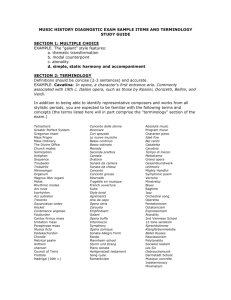
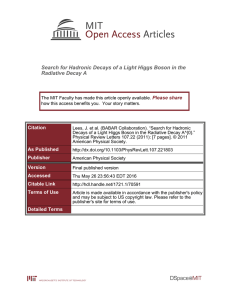
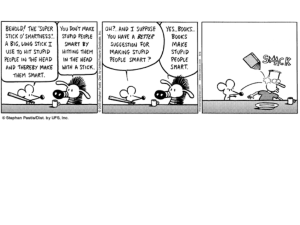
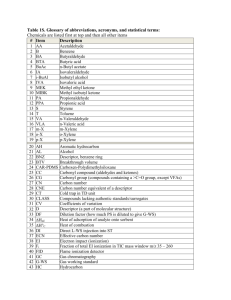
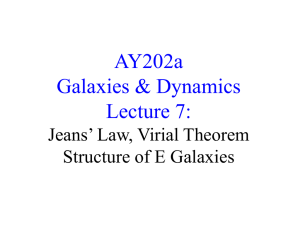
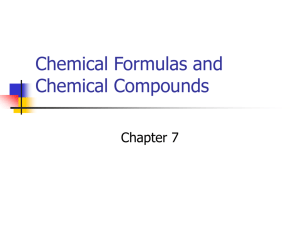
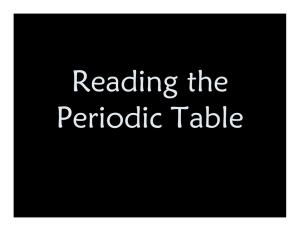
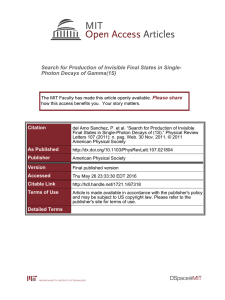
![Observation of the baryonic decay [bar over ]K[superscript +]](http://s2.studylib.net/store/data/012124450_1-001f56a67a858aeb730c0dae2eb8ce7c-300x300.png)

